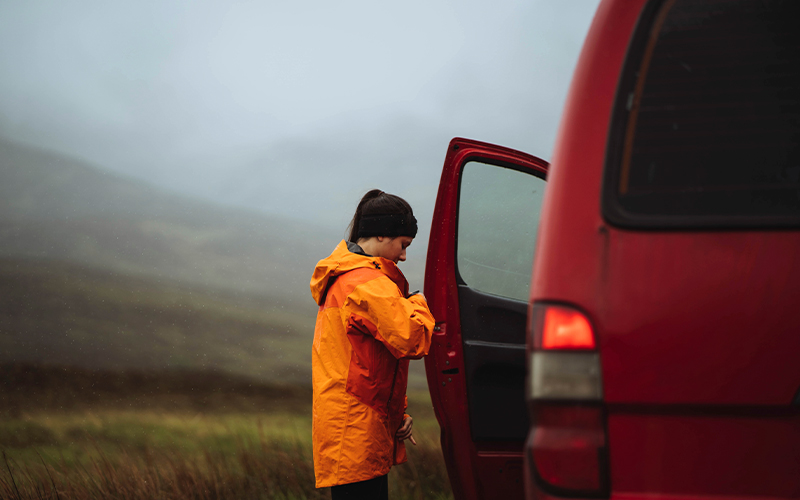Tips for Driving Your Van During Low Visibility

Table of Contents
Low visibility can be a problem all year round, but even more so in the winter months.
While it might be another month until the first official day of winter (22nd December). It’s important to know how to adjust your driving habits before low visibility strikes.
We’ve rounded up our top tips for driving your van in low visibility.
Driving your van at dawn
Getting behind the wheel of your van at dawn can be one of the most difficult driving times. With the sun rising low in the sky, and people on morning walks, driving at this time requires full concentration.
If the sun is getting in your eyes, always keep a pair of polarised sunglasses to hand, or pull down your visor. The sun tends to rise lower in the winter months so it’s always best to prepare.
You are also more likely to feel tired driving first thing in the morning. If you are feeling drowsy, don’t drive. It could put you and other road users at risk.
If you do need to set off in your van before the sun has risen, use dipped headlights until an hour after sunrise.
Driving your van at dusk
Hitting the roads just before the sun goes down is an equally tricky time of day. With reduced light , your eyes will constantly have to adjust which can lead to difficulty focusing.
If you do need prescription glasses or contact lenses for driving, it's even more vital to wear them when driving at night. Make sure to keep your glasses clean to reduce glare and eye strain.
Keeping your van windscreen clean is also imperative when driving at dawn and dusk. A dirty windscreen not only intensifies glare but also limits your view of the road which could lead to an accident.
As light fades it also becomes harder to spot any pedestrians or cyclists. Always adhere to speed limits and be extra cautious of your surroundings.
To improve visibility when driving your van at dusk, remember to switch on dipped headlights an hour before the sun sets.
Many new vans will automatically switch on headlights when it’s dark outside.

Driving your van in snow
Snowy conditions bring a whole new set of challenges when driving. Your van could become harder to control and even get stuck in the snow. That’s why it’s important to adjust your driving habits when the first flakes of snow hit the road.
Top tips for driving in snow:
- Take your time – check the weather before setting off on your journey and only get behind the wheel of your van if it's necessary. If you do need to drive, leave extra time for your journey.
- Leave extra space between you and other vehicles - road surfaces can become slippery in the snow and extend your stopping distance. Leave plenty of room between your van and other vehicles, especially if you are driving a large van with a heavy load.
- Reduce your speed – stick to a lower speed so you have more time to react to what is happening on the road. Reducing your speed also minimises the risk of your van skidding into another vehicle or object.
For more tips on winter driving, read our article on the van driver's guide to winter driving.
Driving your van in fog
Fog can seriously restrict your view of the road and leave you with less time to react to any hazards.
While it might not be that bad when you first hit the road, it can worsen within a matter of minutes.
You should follow a lot of the same habits as driving your van in the snow. Reduce your speed, take your time, and leave extra room between you and other vehicles.
But there’s also a few other things you can do to make driving in fog a bit easier.
- Use fog lights – when visibility is restricted to under 100 metres, it’s important to switch on your fog lights. But it’s recommended that as soon as you come across fog you turn them on. You can invalidate your van insurance if involved in an accident and you aren’t using fog lights.
- Keep windows clear – condensation can build up on your van’s windows as a result of foggy weather. Keep your windscreen wipers moving and use your car heater to keep the inside of the windscreen free from condensation.
- Don’t follow other vehicle’s lights – it might be tempting to get close to the vehicle in front and use their taillights as a navigation aid. But if the vehicle in front suddenly comes to a stop, so will you, posing the risk of an accident.
- Listen to your surroundings – wind your windows down at junctions if visibility is seriously restricted. This will help you listen to other vehicles and judge if it’s safe to pull away.
Above all, don’t complete your journey unless you really have to. If you’re on the road and conditions get worse, take a break at a service station, and wait it out until conditions improve.
Driving your van on ice
Ice is one of the most treacherous conditions you’ll encounter as a van driver. Like driving your van in fog, determine whether your journey is essential.
If it is essential, you’ll need to be extremely careful and aware of your surroundings. While a lot of main roads and motorways will be gritted, residential and country roads might not be.
Leave plenty of time for your journey and drive slowly and carefully to minimise the risk of skidding.
It’s also important to gently increase and decrease your speed. Putting your foot down suddenly can also increase the likelihood of skidding.
Most new vans feature traction control to help you out in a slippery situation. But if your van doesn’t have traction control, use a higher gear to increase your grip on the road.
Is your van set for driving in low visibility?
If not, it could be time to upgrade to a new one. With a new van leasing deal, you’ll benefit from the latest safety features to make driving in low visibility less stressful. There’s also no wear and tear with new vans, meaning you won’t get caught out with van issues.
At Vansdirect, we are the van specialists and can help you find the right van for your needs. We also offer a range of van finance packages, including van leasing, to suit your budget.
But that’s not all. We can also help with van insurance, van maintenance, and more.
Get in touch to start your journey with us today. You’ll be joining over 100,000 happy customers.
Related blog articles
How to Properly Defrost Your Van’s Windscreen
Tips for Driving Different Van Types This Winter
Van Snow Chains vs. Winter Van Tyres: Which is Better?
How to Prepare an Emergency Travel Kit for Your Van in Winter Months
















